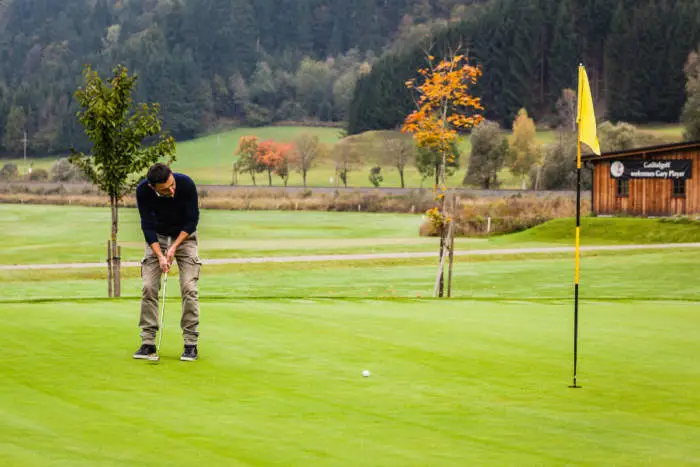What Golf Clubs Do I Need?
Golf is one of the most fun sports in the world and is incredibly popular, but for new players there are a lot of things that can make the game difficult and confusing.
There are unique traditions and language used in the game that can be difficult to get a grasp of at the start, and aside from this, knowing what equipment you need to play can also be a bit of a minefield!
This is because golf does require quite a fair bit of equipment, even for beginners. Even if you have little bit of knowledge of that sport, it can still be intimidating to learn more about what you need to play.
In this guide however, we’re going to help you to solve this problem by highlighting what clubs you need as a beginner and a more experienced player, and introducing what these clubs are used for.
Hopefully this can help you avoid turning up to your first game or a trip to the driving range without the right equipment, and start you on the road to learning the game and improving your swing quickly. If you’re interested in understanding how much all this may cost, check out our guide to the cost of starting to play golf.
The different types of golf clubs
One of the biggest challenges in golf is choosing the right club for the shot you need to take, and getting this aspect of your game down is one of the best ways to improve quickly at golf as you hone your skills and technique.
But first of all, let’s take a look at the different clubs and introduce what they’re used for.
Driver

The driver is the longest and largest club in most golf bags and it’s designed specifically to hit the ball as far and as straight as possible. The whole construction of this club is made to provide power and distance, from the angle of the club face to the length of the club and even the size of the clubhead.
These characteristics are now carefully regulated in golf to ensure that the game is fair, as a number of advancements in materials and design threaten to make the game very unbalanced for those with the best equipment and could label some golf courses too short.
The top professional golfers can hit the driver in excess of 300 yards, whilst low handicap golfers (0-5) tend to average around the 250 yards mark (full study by Arccos Golf). Even novices can achieve distances of 250 yards with a little practice and the right technique.
However, given the distance the ball travels, being slightly off line makes the driver probably one of the most difficult clubs to use where a bad swing can easily cause you to lose your ball or send your tee shots wildly into the rough.
Almost all golf sets need a driver to tackle even a modest golf course, but beginners or those playing shorter pitch and putt courses shouldn’t need one.
Woods

Woods are similar to drivers in that they are designed for distance, but with a little more control in that they hit a slightly shorter distance and focus more on elevation and hitting the ball off the ground directly, although you can still hit them off a tee like the driver.
Woods are versatile and can still reach impressive distances of over 250 yards in some cases. Like a driver, they can be difficult to use for beginners and may require a little more technique and practice.
They are called woods as they traditionally used to be made from wood material. Technology has advanced over the years though, and they’re now mainly made of titanium albeit the name has stuck around, but you may hear some golfers referring to them as a “metal”.
Most basic golf sets will include at least one wood with the most common woods being the 3 wood and 5 wood.
Irons
Irons are the core of any golf set and are what most people think of when they imagine a typical golf club.
The clubhead of a golf iron is “bladed” and has a club face angle designed for elevation as well as good distance depending on the specific iron being used.
For example, the lower irons such as the 3, 4 or 5 are more geared towards distance and have a steeper club face and angle, while the higher irons such as the 8 and 9 iron are geared towards elevation to hit shorter distances and allow you to hit over trees, bunkers and whatever else may be in your line as required. If you’re interested in how irons are designed, check out our guide to lofts of different golf clubs in the bag.
Golf iron sets are traditionally sold as 6 or 7 iron sets, from 4 – PW (pitching wedge) or 5 – PW. This should mean you have a good array of clubs that are capable of allowing you to play all types of shots over varying distances.
Wedges
Wedges are designed especially for approach play and are your go to tools for your short game. Wedges have a lot of loft, traditionally 48 degrees or more, allowing golfers to chip over bunkers and water due to the high elevation shot the lofts promote.
These clubs are fun to use and are usually there for approach play and chipping or pitching around the green. The sand wedge is your friend when you hit your ball into a bunker and the loft and bounce on the club is designed to help you escape the trouble!
Wedges are versatile and important tools and most golf bags. They are ideal for playing pitch and putt courses so even the most basic sets, will include at least a pitching wedge and often a sand wedge in order to give you the tools you need to navigate the short game effectively.
Putter

No golf set is complete without a putter! This essential club will sit in every golf bag as it’s the only club capable of reliably putting the ball in the hole which at the end of the day is the objective of the game.
There are many different types of putters, from mallets to putter blades, which basically dictates the size of the putter head, but they are all designed with the same objective – exclusively for putting on the green. Putters are the shortest club in the bag, but also the club with the least loft. Although they may appear flat faced, they do tend to have a few degrees loft to get the ball rolling quickly on the green.
What makes a full set?
Golf bags are very personal things and will vary heavily on the type of golfer, the distance they hit it and the confidence they have with some of the more difficult clubs to hit such as woods and long irons.
While a lot of golfers will have their own preferences for what makes a full set, there are generally agreed upon clubs that constitute part of a full set. These include:
- Driver
- Wood
- 4, 5, 6, 7, 8, 9 Iron
- Pitching wedge (PW)
- Sand wedge (SW)
- Putter
These are really the clubs which are essential for a basic golf set, however you can carry up to 14 clubs in a golf bag, so there are some additional clubs that professionals and serious players will add to expand their options on the course.
Specialist clubs
The specialist clubs that some players will include options like lob wedges, gap wedges, 4 hybrids, 5 hybrids and 5 woods.
These clubs all fill specific distance gaps within a golfer’s bag and can make a huge difference at high level play where every advantage and degree of precision count for everything.
For example, if you only have a 3 wood (which you hit 230 yards) and your next longest club is a 4 iron (which you hit 180 yards), if you come up to a par 3 which is 200 yards, you’re going to be pretty screwed as you don’t have a club to hit the yardage. So these clubs are mainly used to fill the gaps and mitigate these issues on the course
However at lower levels of play these clubs are uncommon as players don’t necessarily have the skill or need to leverage them properly, meaning that they are reserved for higher skilled and more experienced players and most sets as standard won’t include these clubs.